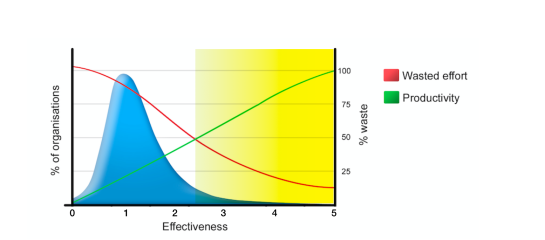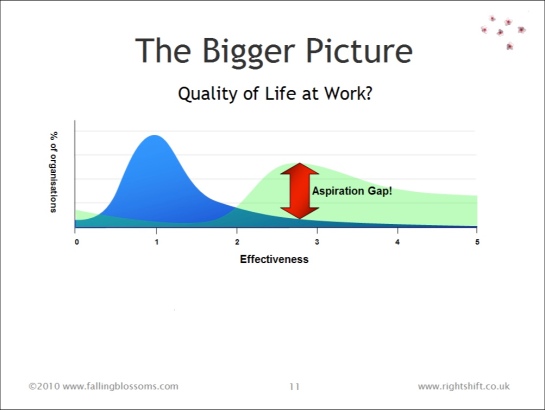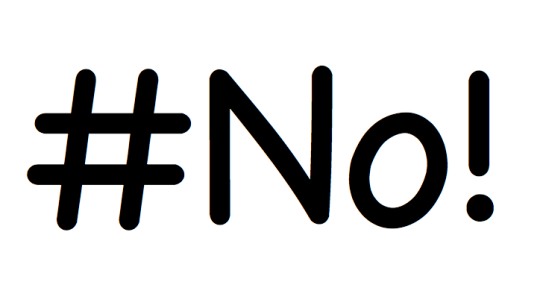World Class? Really?
Some six years ago now, I wrote a post describing what might characterise a world class software / product development / collaborative knowledge work business.
In the interim, I’ve had some opportunities to work on these ideas for various clients. My consequent experiences, whilst in no way invalidating that post, have thrown up different perspectives on the question of “world class”.
Firstly, do you want it? Moving towards becoming a world class business involves a shed load of work, over many years. Do you want to commit to that effort? Even though the goal sounds noble, ambitious, attractive, does your business have what it takes to even begin the journey in earnest, let alone stick at it.
Then, do you need it? Absent powerful drivers spurring you on towards the goal, will you have the grit necessary to keep at it? Or will the initiative flounder and drown in the minutiae of daily exigencies, such as the constant pressure to get product and features out the door, to keep investors satisfied with (short term) results, etc.? And is the ROI there, in your context? If you do keep on the sometimes joyful, oftentimes wearisome path, and attain “world class” status, will the effort pay back in terms of e.g. the bottom line?
If your answers to the preceding two questions are yes, then we can get down to considering the characteristics of a world class collaborative knowledge-work business.
What might it look like, that goal state? Here’s my current take:
Context
Just in case a little context might help, here’s a variant of the Rightshifting chart which illustrates world class in terms of relative effectiveness (i.e. how effective are world class organisations relative to their peers?) The yellow area highlights those organisations (those at least circa 2.5 times more effective than the median) we might consider world class:

Fields of Competency
Any world class collaborative knowledge-work business must have mastered a bunch of different fields of knowledge. That’s not to say everyone in the organisation needs to have reached mastery (Level 5 – see below) in every one of the follow fields. But there must be a widespread acquaintance with all these fields, and some level of individual competent in each.
I suggest the following Dreyfus-inspired model for characterising an individual’s (practitioner’s) level of competency (or action-oriented knowledge) in any given field:
Level One (Novice)
The Novice level in each Field invites practitioners to acquire the basic vocabulary and core concepts of the Field. Attainment criteria will specify the expected vocabulary and core concepts. The Novice level also invites practitioners to acquire and demonstrate the ability to read and understand materials (books, articles, papers, videos, podcasts, etc.) related to the vocabulary and core concepts of the Field.
Level Two (Advanced Beginner)
The Advanced Beginner level in each Field invites practitioners to acquire the ability to critique key artefacts commonly found in the given Field. The Advanced Beginner level also invites practitioners to read more widely, and understand different perspectives or more nuanced aspects of, and peripheral or advanced elements within the Field.
Level Three (Competent)
The Competent level in each Field invites practitioners to acquire and demonstrate a practical competency in the core concepts in the Field, for example through the ability to apply the concepts, or create key artefacts, unaided.
The Competent level also invites practitioners to acquire and demonstrate the ability to collaborate with others in exploring and applying the abilities acquired in the Novice and Advanced Beginner levels.
Level Four (Proficient)
The Proficient level in each Field invites practitioners to acquire and demonstrate the ability to prepare and present examples and other educational materials appropriate to the given Field. The Proficient level also invites practitioners to acquire and demonstrate the ability to coach or otherwise guide others in applying the abilities acquired in the Novice, Advanced Beginner and Competent levels.
Level Five (Master)
The Master level in each Field invites practitioners to acquire and demonstrate national or international thought leadership in the Field. This can include: making significant public contributions or extensions to the Field; becoming a publicly recognised expert in the Field; publishing books, papers and/or articles relevant to the Field; etc.
The Fields
Any business that aspires to world class status must attain effective competencies in a wide range of different fields. The following list suggests the fields I have found most relevant to collaborative knowledge-work business in general, and software / product tech businesses in particular:
Flow
- Flow (product development) (n): the movement of the designs, etc., for a product or service through the steps of the design processes which create them.
- Continuous Flow (n): The progressive movement of units of design through value-adding steps within a design process such that a product design or service design proceeds from conception into production without stoppages, delays, or back flows.
- See also: Optimised Flow Demonstration (video)
Deming
- * Many in Japan credit Bill Deming for what has become known as the Japanese post-war economic miracle of 1950 to 1960.
- William Edwards Deming (October 14, 1900 – December 20, 1993) was an American engineer, statistician, professor, author, lecturer, and management consultant. Deming is best known for his work in Japan after WWII, particularly his work with the leaders of Japanese industry.
Risk Management
- Risk management is the discipline and practice of explicitly identifying and managing key risks.
“Risk Management is Project Management for grown-ups.”
~ DeMarco & Lister
- Potential benefits include:
- makes aggressive risk-taking possible
- protects us from getting blindsided
- provides minimum-cost downside protection
- reveals invisible transfers of responsibility
- isolates the failure of a subproject
- Note; Many Agile practices are, at their heart, about risk management.
Mindset
- Mindset a.k.a. collective (organisational) memeplex (n): A set of memes (ideas, assumptions, beliefs, heuristics, etc.) which interact to reinforce each other.
“A memeplex is a set of memes which, while not necessarily being good survivors on their own, are good survivors in the presence of other members of the memeplex.”
~ Richard Dawkins in The God Delusion
- The “organisational mindset” is a set of beliefs about the world and the world of work which act to reinforce each other.
- These interlocking beliefs tightly bind organisations into a straight-jacket of thought patterns which many find inescapable. Without coordinated interventions at multiple points in the memeplex simultaneously, these interactions will prevail, as will the status quo.
Requirements a.k.a. Needs Management
- A more or less formal approach to identifying and communicating needs
- Any approach that ensures that everyone involved in attending to the identified needs shares a clear understanding of the required outcome(s): “doing the RIGHT thing”.
Fellowship
- A system of organisational governance based on the precepts of Situational Leadership and with a primary focus on the quality of interpersonal relationships as a means to improved organisational health and effectiveness.
- More generally, paying attend to the quality and effectiveness of the collaborative relationships across and through the business (and the extended value network of which it is a part).
Cognitive Function
- Cognitive function (Neurology) (n): Any mental process that involves symbolic operations–e.g. perception, memory, creation of imagery, and thinking; Cognitive Function encompasses awareness and capacity for judgment.
- Effectiveness of collaborative knowledge work is dictated by both e.g. quality of interpersonal relationships and degree of Cognitive Function.
- See also: Cognitive Science
PDCA
- PDCA (plan–do–check–act, or plan–do–check–adjust) is an iterative four-step method used for the control and continuous improvement of processes and products. It is also known as the Deming circle/cycle/wheel, Shewhart cycle, control circle/cycle, or plan–do–study–act (PDSA).
- Based on the scientific method, (Cf. Francis Bacon) e.g. “hypothesis” – “experiment” – “evaluation”.
Statistical Process Control (SPC)
- Statistical process control (SPC) is a method of quality control which uses statistical methods. SPC is applied in order to monitor and control a process.
- Key tools used in SPC include control charts; a focus on continuous improvement; and the design of experiments.
- See also: The Red Beads and the Red Bead Experiment with Dr. W. Edwards Deming (video)
Lean Product Development
- Lean Product Development applies ideas from Lean Manufacturing to the design and development of new products (See e.g. books by Allen Ward and Michael Kennedy)
- Aims to improve the flow of new ideas “from concept to cash”.
- Can also help raise levels of innovation.
- Exemplar: TPDS (Toyota Product Development System)
Don Reinertsen’s Work
- Don Reinertsen is the author of three of the most definitive and best-selling books on product development.
- His 1991 book, Developing Products in Half the Time is a product development classic.
- His 1997 book, Managing the Design Factory: A Product Developer’s Toolkit, was the first book to describe how the principles of Just-in-Time manufacturing could be applied to product development. In the past 16 years this approach has become known as Lean Product Development.
- His latest award-winning book, The Principles of Product Development Flow: Second Generation Lean Product Development, has been praised as, “… quite simply the most advanced product development book you can buy.”
Neuroscience
- (Cognitive) neuroscience is concerned with the scientific study of the biological processes and aspects that underlie cognition, with a specific focus on the neural connections in the brain which are involved in mental processes.
- (Cognitive) neuroscience addresses the questions of how psychological/cognitive activities are affected or controlled by neural circuits in the brain. Cognitive neuroscience is a branch of both psychology and neuroscience, overlapping with disciplines such as physiological psychology, cognitive psychology, and neuropsychology.
- See also: Cognitive Function
Theory of Constraints
- The Theory of Constraints (TOC) is a management paradigm originated by Eliyahu M. Goldratt.
- TOC proposes a scientific approach to improvement. It hypothesises that every complex system, including manufacturing processes, consists of multiple linked activities, just one of which acts as a constraint upon the entire system (the “weakest link in the chain”).
- TOC has a wide range of “thinking tools” which together form a coherent problem-solving and change management system.
Self-organisation
- Self-organisation (n): Ability of a system to spontaneously arrange its components or elements in a purposeful (non-random) manner. It is as if the system knows how to ‘do its own thing.’ Many natural systems such as cells, chemical compounds, galaxies, organisms and planets show this property. Animal and human communities too display self-organization.
“An empowered organization is one in which individuals have the knowledge, skill, desire, and opportunity to personally succeed in a way that leads to collective organisational success.”
~ Stephen R. Covey
Quantification
- In mathematics and empirical science, quantification is the act of counting and measuring that maps human sense observations and experiences into members of some set of numbers. Quantification in this sense is fundamental to the scientific method.
- See also: Tom Gilb
Systems Thinking
- Systems thinking provides a model of decision-making that helps organisations effectively deal with change and adapt.
- It is a component of a learning organisation – one that facilitates learning throughout the organisation to transform itself and adapt.
- See also: Peter Senge, Russell L. Ackoff, Donella Meadows, etc.
Psychology
- Psychology (n): the study of behaviour and mind, embracing all aspects of conscious and unconscious experience as well as thought. It is an academic discipline and an applied science which seeks to understand individuals and groups.
Argyris
- An American business theorist, Professor Emeritus at Harvard Business School, and known for his work on interpersonal communication, organisational effectiveness, double-loop learning and learning organisations.
- See also: Action Science.
Psychotherapy
- Psychotherapy (n): interventions which facilitate the shifting of perspectives and attitudes, and thus, human behaviours.
- See also: Organisational Psychotherapy
To the above list of Fields, I invite you to add any which may have specific resonance or relevance to your own business.
And then there are the lists of technical capabilities you need to be present in your various business functions, too.
Aside – CMMI
As an aside, CMMI also provides an extensive list of “capability areas” ( circa 128 different areas, last time I looked) focussed on engineering capabilities. Note: I find the CMMI list useful, but only as a primer, not as a full-blown recipe for success.
Summary
All the above begs the question: how to get there? And, how close are you to world class, so far?
– Bob








